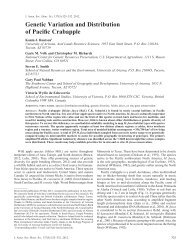CONSERVATION
Conservation You Can Taste - The Southwest Center - University of ...
Conservation You Can Taste - The Southwest Center - University of ...
- No tags were found...
Create successful ePaper yourself
Turn your PDF publications into a flip-book with our unique Google optimized e-Paper software.
BEST PRACTICES<br />
AT THE SAME TIME, there are many challenges facing the conservation of<br />
agricultural biodiversity and the market recovery of heritage foods, there are many<br />
best practices embedded in the case studies presented here that could potentially help<br />
other heritage foods to be recovered:<br />
1. Most successful heritage food recovery efforts have required a collaborative<br />
conservation mentality to recognize that it may “take a village” of heterogeneous<br />
participants—farmers, breeders, marketers, chefs, etc of all political persuasions<br />
and ethnic or racial backgrounds—to help recover a variety, species or food tradition.<br />
Collaborative rather than command-and-control behaviors will likely work<br />
best over the long haul.<br />
2. Many heritage food recovery efforts simply start with confidence-building<br />
between farmers and chefs who share common values; the building of crosssectoral<br />
relationships and lasting friendships matter perhaps more than any other<br />
social factor in assuring success.<br />
3. Newly recruited chefs or consumers are ultimately attracted to a heritage<br />
food by its flavor, color, texture or shape, and how the person resonates with its<br />
story. People are not only willing to pay for the caloric value of these foods; they<br />
are willing to pay for the cultural and ecological value of them. Tell the rich back<br />
story of the food, its related foodways, and its producers.<br />
4. Focus on means to make the food not only accessible but affordable. Heritage<br />
food promoters should not shirk from finding innovative means to reintroduce<br />
these foods to low income consumers who need to purchase them at just<br />
prices. For instance, Wholesome Wave’s double-the-value program for SNAP program<br />
recipients can be used to purchase seeds, seedlings or cuttings of food plants<br />
at farmers markets. If low income families are most nutritionally at risk, it may be<br />
72



